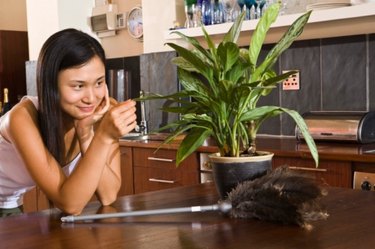Things You'll Need
Mask
Black tarp
Shovel
Fungicide
Insecticidal soap
Pruners
Trowel
Fan
Potting soil
Water
Bleach

It is common to see mold and its partner mildew on plants and in soil. Mildew, a growth produced by molds, can appear ashy, white or blue-green. Mold is a simple form of plant life belonging to the family of fungi. Both appear when conditions are moist to overly wet and when there is a lack of heat and air circulation. Molds are found in outdoor soils, usually in pots, but also in shady, overly crowded areas that retain moisture. Indoor molds and mildew do not hurt plants but can be a problem for people with allergies.
Outdoor Removal
Step 1
Put a mask over your mouth and nose if you are sensitive to allergens. Spread the black tarp out in a sunny, open location. Scrape off the top half inch of soil in outdoor beds that have been infected with mold and mildew. This will remove the organisms in the soil that are making mold appear.
Video of the Day
Step 2
Spread the soil out on the tarp and let it dry in the sun for a day. Every two or three hours disturb and redistribute the soil so all the particles are exposed to the heat and light. The sun will kill the mold spores and in turn the mildew. Return the soil to the garden bed after it has "cooked" for a day.
Step 3
Use a fungicide to spray any foliage in the bed that has mildew on it, following manufacturer's instructions. To prevent the problem from recurring, prune limbs on trees or shrubs that may be hindering sunlight. Allow a little sun into the garden bed and increase the air movement by removing overcrowded vegetation.
Step 4
Look for the presence of aphids or scale insects, which secrete honeydew as a byproduct of their feeding, a sweet substance that will cause sooty mold. This will usually form on foliage, but it can drip onto soil. Get rid of the pests with a safe insecticidal soap, using as directed.
Indoor Removal
Step 1
Put on your mask if you are affected by allergens. Scrape off the top surface of the soil where you see mold and dispose of it. Move the plant to a warmer area to dry out the soil. Do not water for a few days or until soil is dry. The presence of mold and mildew indoors indicates too much moisture, which is probably from over-watering.
Step 2
Place a fan in the room where the plant is kept. An increase in air circulation will help keep the soil from staying so sodden and giving mold spores an opportunity to grow. Alternatively, you can put the plant outside for two or three days, if it is not too cold for the plant.
Step 3
Check the plant for the presence of insects. Ants in the pot can indicate the presence of aphids. Ants and aphids are often together because aphids produce honeydew, which ants love. Honeydew in turn forms sooty mold. You should put the plant in the sink and rinse it off or spray the plant with an insecticidal soap. Some types of scale insects also produce honeydew.
Step 4
Look the soil over carefully in a week. If mold and mildew are still present, you will have to re-pot. Before filling the pot with new soil, wash the pot thoroughly in a gallon of water with a tablespoon of bleach. This will kill any spores or disease the pot may still contain. Let the pot air dry completely, then fill with soil and re-pot the plant.
Video of the Day